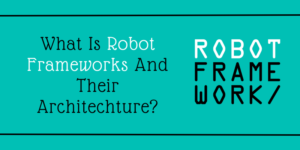What Is Robot Frameworks And Their Architecture?
To implement Agile and Test Driven Development (TDD), where developers should only write functional code when a test has failed, many organisations have turned to the Robot framework as a go-to alternative. Robot framework supports robotic process automation (RPA), behaviour-driven testing, and acceptance test-driven development (ATDD).
It provides a flexible keyword-driven testing automation technique. The learning curve is low because the Robot framework can be used without prior programming knowledge.
Although the Robot Framework is written in Python, it is not only that. Python, Java, JavaScript, Perl,.Net, and PHP can all be used to implement keywords in the Robot framework.
Run your first Python Selenium testing script with the help of this blog on the Robot framework. Additionally, we will investigate utilising Robot and Selenium to execute automation scripts for more complicated scenarios. Keyword-driven testing with Robot in Python would be implemented using Selenium to provide automated browser testing.
Robot Frameworks Architecture
The architecture of the Robot framework is entirely modular, as explained below. It uses keyword-driven testing and is not technology-specific. With the available keywords, users can generate more specific keywords. Users can construct test libraries in several programming languages and create keywords.
1)Test Data
Test data is supplied in tabular form as the first layer of the Robot structure. Data management is easy due to the tabular format of the data. This test data is the input to the Robot framework, which begins processing it as soon as it receives it and produces reports and logs after execution. HTML and XML formats are used for the information. The generated reports cover every line run as part of the test case. Join Robot Framework Test Automation Online Course to learn more about test data.
2)Robot Framework
The main benefit of the Robot framework is that it doesn’t care which target is being tested. Libraries that leverage application interfaces, whether built-in or user-created, can be used to communicate with the layers beneath the framework.
3)Test Libraries
The code is portable and manageable since the Robot framework only communicates with the other system levels through libraries. Libraries are often imported [in the *** Settings *** section] at the beginning of the implementation.
4)System Under Test
The testing activity is carried out on this target. It could be a website or a web application. The interface between the Robot Framework and the tested system is provided via libraries. Hence, the framework has no direct communication channel with the system being tested. The Robot framework supports the following file types: plain text, HTML, TSV (tab-separated values), and reST (restructured text). According to the Robot framework’s official documentation, the simple text format is advised.
Conclusion:
This blog will tell you more about robot frameworks and their architecture. To learn more about robot frameworks, join Robot Framework Test Automation Course In Chennai at FITA Academy.


